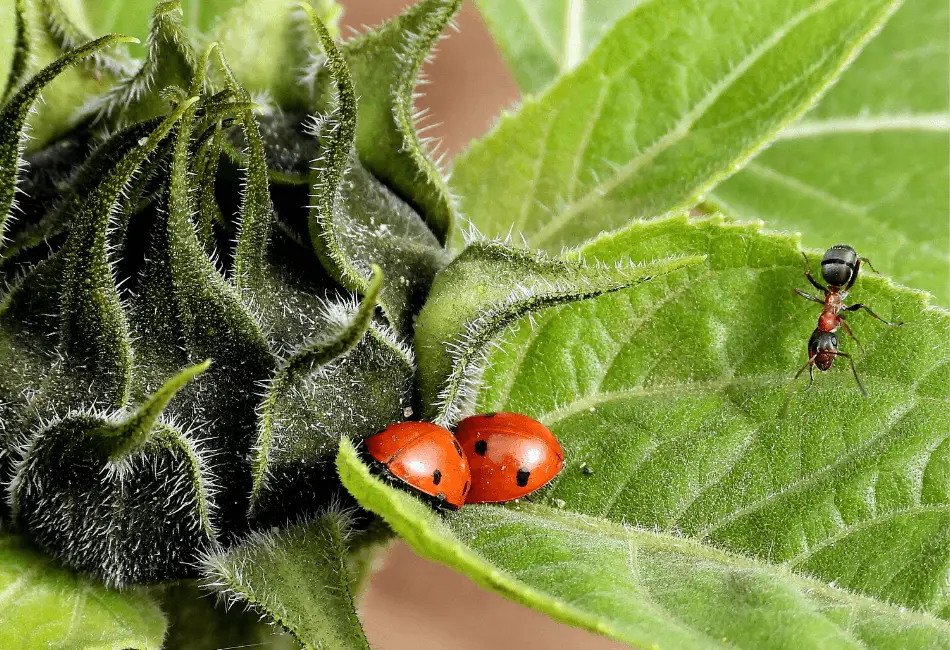Ladybugs tend to be one of the more tolerable insect types. To some people they are viewed as cute, even when caught lingering around the home. Ladybugs are often admired for their round bodies, orangish-red coloring, and of course, their black spots. They certainly do not have that creepy factor that many people associate with other insects or spiders.
However, when it comes to the animal and insect world, cute appearances don’t always translate into tame diets. In other words, adorable looking creatures often make a meal of some pretty nasty things. Cats eat mice, beautiful birds eat worms, and list goes on.
But, what about the diet of ladybugs? We will take a look at what they eat and specifically if they eat ants.
Table of Contents
Do Ladybugs Eat Ants?
Ladybugs do not eat ants. However, it is not unusual for ladybugs and ants to come in close contact. Ladybugs commonly eat aphids (more on this below). Certain ants, on the other hand, are attracted to aphids because of their sweet tasting waste material called honeydew that they eat. You can likely see how this can create a conflict between ladybugs and ants. One wants to eat the aphids where the other wants it alive to continue to produce waste.
Since some ants rely on aphids for their sugary waste material, they provide protection for the aphids. This often means ants must battle predators, such as a ladybugs, in an attempt to ward them off. The University of Wisconsin-Madison notes that certain ants will go the extra mile to protect their aphid food source. This can include ants building shelter for aphids or even transporting them to another plant when the plant’s sap runs dry [3].
The video below shows the extent ants will go to protect their aphid food supply. The bigger ladybug has a difficult time defending itself against a group of ants.
What Do Ladybugs Eat?
As indicated above, the preferred food of many ladybugs are aphids. Aphids are tiny bugs that feed off the sap of plants. Their feeding behavior can damage or kill vegetation. Ladybugs are a welcome site for farmers looking to control aphid infestation. Ladybugs will eat a large quantity of aphids, but aphids reproduce so quickly that ladybugs alone often are not enough to completely eliminate the problem [1].
You can purchase ladybugs online to reduce the population of aphids in your home garden. These Clark & Co Organic live ladybugs are an example of ladybugs that can be shipped to the home for aphid control. A single ladybug can eliminate up to 50 aphids a day without harming plants. Over a lifetime, one ladybug can eat up to 5,000 aphids [2].
However, not all ladybugs are the same in regard to their diet. Depending on the species of ladybug, they may feed on plants, whiteflies, mildew, mites, mealybugs, and several other types of of insects.
Are Ladybugs Harmful in the Home?
Ladybugs are actually an insect that can be beneficial in a home in limited numbers, of course. House plants can have aphids just like outdoor vegetation. Adding ladybugs on indoor plants can help solve an aphid problem. This is especially true since the ladybugs will likely not have to contend with ants or other bothersome creatures in the comfort of your home. You have to be certain to only introduce ladybugs that eat aphids since certain ladybugs do eat plants or aren’t interested in a diet of aphids.
Of course, most people do not invite ladybugs into their home. They typically find a way inside during the fall as they seek warmth for the cooler days ahead. They rest during the winter months and awaken to look for a way outside as the warmer days of spring roll around. Ladybugs aren’t the type of insect that will do structural damage to a home or cause harm to humans or pets. However, if one enters the home, you may have many since others can be attracted by pheromones produced by the ladybug(s) inside [4].
Do not smash ladybugs since they contain a substance that has the ability to stain. It is best to leave them until they can make their way outside to be a benefit to the garden. If this is not ideal for you, vacuuming them up is often the best option. Other options include live traps or pyrethroid insecticides.
References:

